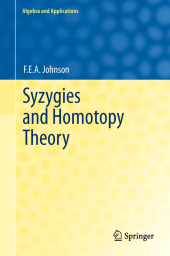 Neuerscheinungen 2014Stand: 2020-02-01 |
Schnellsuche
ISBN/Stichwort/Autor
|
Herderstraße 10
10625 Berlin
Tel.: 030 315 714 16
Fax 030 315 714 14
info@buchspektrum.de |

F. E. A. Johnson
Syzygies and Homotopy Theory
2012. 2014. xxiv, 296 S. 1 SW-Abb.,. 235 mm
Verlag/Jahr: SPRINGER, BERLIN; SPRINGER, LONDON 2014
ISBN: 1-447-15812-1 (1447158121)
Neue ISBN: 978-1-447-15812-7 (9781447158127)
Preis und Lieferzeit: Bitte klicken
This book explores the problem of nonsimply connected homotopy in the first nontrivial cases and presents a systematic rehabilitation of Hilbert´s method of syzygies in the context of non-simply connected homotopy theory.
The most important invariant of a topological space is its fundamental group. When this is trivial, the resulting homotopy theory is well researched and familiar. In the general case, however, homotopy theory over nontrivial fundamental groups is much more problematic and far less well understood.
Syzygies and Homotopy Theory explores the problem of nonsimply connected homotopy in the first nontrivial cases and presents, for the first time, a systematic rehabilitation of Hilbert´s method of syzygies in the context of non-simply connected homotopy theory. The first part of the book is theoretical, formulated to allow a general finitely presented group as a fundamental group. The innovation here is to regard syzygies as stable modules rather than minimal modules. Inevitably this forces a reconsideration of the problems of noncancellation; these are confronted in the second, practical, part of the book. In particular, the second part of the book considers how the theory works out in detail for the specific examples F n F where F n is a free group of rank n and F is finite. Another innovation is to parametrize the first syzygy in terms of the more familiar class of stably free modules. Furthermore, detailed description of these stably free modules is effected by a suitable modification of the method of Milnor squares.
The theory developed within this book has potential applications in various branches of algebra, including homological algebra, ring theory and K-theory. Syzygies and Homotopy Theory will be of interest to researchers and also to graduate students with a background in algebra and algebraic topology.
Preliminaries.- The restricted linear group.- The calculus of corners and squares.- Extensions of modules.- The derived module category.- Finiteness conditions.- The Swan mapping.- Classification of algebraic complexes.- Rings with stably free cancellation.- Group rings of cyclic groups.- Group rings of dihedral groups.- Group rings of quaternionic groups.- Parametrizing W1 (Z) : generic case.- Parametrizing W1 (Z) : singular case.- Generalized Swan modules.- Parametrizing W1 (Z) : G = C Yen F.- Conclusion.
From the reviews:
"The book Syzygies and Homotopy Theory is concerned with the algebraic classification of certain finite dimensional geometric complexes with a nontrivial, finitely presented fundamental group G and is directed towards to basic problems ... . Syzygies and Homotopy Theory is well written, nicely organized, and is a pleasure to read. One particularly attractive feature of the book is its attention to detail, and the background chapters may well appeal to an audience wider than that of specialists." (Marek Golasinski, Zentralblatt MATH, Vol. 1233, 2012)


